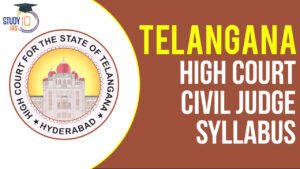Daily Current Affairs for UPSC 2023
Q) Which one of the following statements is correct about the Convention on International Trade in Endangered Species of Wild Fauna and Flora (CITES)?
- It is an agreement to ban trade in wild animals.
- It is legally binding.
- Its secretariat is managed by United Nation Development Program.
- There are 192 parties to the convention.
Daily Current Affairs for UPSC – 3 March 2023
Explanation:
- Option (1) is incorrect: CITES (Convention on International Trade in Endangered Species of Wild Fauna and Flora) is an international agreement between governments to ensure that international trade in specimens of wild animals and plants does not threaten their survival. CITES was drafted as a result of a resolution adopted in 1963 at a meeting of members of IUCN (World Conservation Union). Text of Convention was finally agreed in Washington in 1973 and entered into force in 1975.
- Option (2) is correct: Although CITES is legally binding on the Parties, it does not take the place of national laws. Rather it provides a framework to be respected by each Party, which has to adopt its own domestic legislation to ensure that CITES is implemented at the national level. The species covered by CITES are listed in three Appendices, according to the degree of protection they need.
- Option (3) and (4) are incorrect: The CITES secretariat is administered by United Nations Environment Programme (UNEP) and is located at Geneva, Switzerland. There are currently 184 parties (including India) to the Convention. All 184 Parties to CITES have right to attend, to put forward proposals to consider, and to vote on all decisions. Convention on International Trade in Endangered Species of Wild Fauna and Flora (CITES). March 3, 2023, World Wildlife Day marks the 50th anniversary of the Convention on International Trade in Endangered Species of Wild Fauna and Flora (CITES) in 1973.
Q) Consider the following pairs:
| Forms of economic recovery | Features | |
| 1. | K shaped recovery | -When different parts of the economy recover at different rates |
| 2. | L shaped recovery | – A rapid and sudden improvement in an economy that follows a rapid and severe fall. |
| 3. | U shaped recovery | -Economy experiences a rapid collapse, followed by a temporary recovery. |
| 4. | W shaped recovery | -It is followed by a period of economic stagnation |
How many of the pairs given above is/ are correctly matched?
- Only one pair
- Only two pairs
- Only three pairs
- All four pairs
Explanation:
- Pair 1 is correctly matched: A K-shaped recovery occurs when, following a recession, different parts of the economy recover at different rates, times, or magnitudes. This contrasts with an even, uniform recovery across sectors, industries, or groups of people. It causes such changes in the structure of the economy or the broader society as economic outcomes and relations are fundamentally changed before and after the recession. It is called K-shaped, because the path of different parts of the economy when charted together may diverge, resembling the two arms of the Roman letter “K.”
- Pairs 2 and 3 are incorrectly matched: V-Shaped recovery is a rapid and sudden improvement in an economy that follows a rapid and severe fall. This usually happens following a one-time shock to the economy. In U-Shaped recovery the economic damage in this type lasts for a longer amount of time before returning to the baseline level of growth.
- L-shaped: In this form, the economy rebounds to some extent from a sharp dip, but growth fails to return to pre-crisis levels, if at all. It is followed by a period of economic stagnation
- Pair 4 is incorrectly matched: In W-shaped recovery the economy experiences a rapid collapse, followed by a small and temporary recovery, and then another decline. It is also known as a double-dip recession. -shaped recovery the economy rebounds to some extent from a sharp dip, but growth fails to return to pre-crisis levels, if at all. It is followed by a period of economic stagnation.
Q) With reference to ‘Integrated Battle Groups (IBG)’, consider the following:
- IBG are self-sufficient, brigade-sized fighting units that can quickly initiate attacks on an enemy.
- A major general will serve as the leader of each IBG.
- They will deploy only offensive measures against the enemy.
Which of the statements given above is/are correct?
- 1 only
- 1 and 2 only
- 2 and 3 only
- 1, 2 and 3
Explanation:
- Statement 1 is correct: Integrated Battle Groups (IBG) are brigade sized agile self-sufficient combat formations which can swiftly launch strikes against adversary in case of hostilities. Its objective is to make the force more lethal and suitable to fight a modern war with the support of technology. Recently, the Chief of Army Staff announced to convert the “Battle Squads” into “Integrated Battle Groups” in an effort towards structuring and optimization of the force.
- Statement 2 is correct: Each IBG would be tailor made based on Threat, Terrain and Task and resources will be allotted based on the three Ts. They need to be light so they will be low on logistics. They will be able to mobilize within 12-48 hours based on the location. IBGs will be bigger than a brigade (3,000- 3,500) but smaller than a division (10,000- 12,000). Each IBG will likely be headed by a Major General.
- Statement 3 is incorrect: IBGs involve the integration of infantry, armoured tank regiments, artillery, Unmanned Aerial Vehicles (UAVs), combat engineers and signals into one fighting unit. IBGs will be defensive and offensive: While the offensive IBGs would quickly mobilize and make thrust into enemy territory for strikes, defensive IBGs would hold ground at vulnerable points or where enemy action is expected. The composition of every IBG would differ on the basis of the terrain where it is located — an IBG operating in a desert needs to be constituted differently from one operating in the mountains.
Q) Consider the following statements about ‘Lewis super-acids’:
- It is any substance that can take in a pair of non-bonding electrons.
- They are often used to slow down chemical reactions.
- Since they can dissolve even the most difficult bonds, Lewis super acids are more powerful than antimony penta-fluoride.
Which of the statements given above is/are correct?
- 1 only
- 1 and 2 only
- 2 and 3 only
- 1 and 3 only
Explanation:
- Statement 1 is correct:Researchers in Germany have made a unique class of catalysts called Lewis super-acids. Named for the chemist, G N Lewis, Lewis super-acids derive from Lewis acids. A Lewis acid is any substance, such as a Hydrogen ion (H+) that can accept a pair of non-bonding electrons. In other words, a Lewis acid is an electron-pair acceptor. A Lewis base is any substance, such as the OH- ion, that can donate a pair of non-bonding electrons. A Lewis base is therefore an electron-pair donor.
- Statement 2 is incorrect but statement 3 is correct:As Lewis acids add electron pairs, they are often used to speed up chemical reactions. Lewis super acids are stronger than antimony pentafluoride which is the strongest Lewis acid and can break even the toughest bonds. Breaking strong, chemical bonds require highly reactive substances. As they are so reactive, they are hard to manufacture
Q) Which one of the following statements best describes the term ‘de-growth communism’?
- It is a phenomenon where the communist countries experience slow growth.
- A scenario where the central bank increases interest rates which causes slowdown in economy.
- The development of political parties which supports communist ideologies in a democratic country.
- A democratically planned effort to downscale levels of production and consumption to lighten environmental pressures.
Explanation:
- Option (4) is correct: Economic growth is fuelling climate change-a new book proposes ‘degrowth communism’ as the solution. Degrowth is a democratically planned effort to downscale levels of production and consumption in order to lighten environmental pressures. Degrowth communism could halt the escalating climate emergency. Degrowth could act as an emergency brake on vicious cycle, by “terminating the ceaseless exploitation of humanity and the robbery of nature”.


 Telangana High Court Civil Judge Syllabu...
Telangana High Court Civil Judge Syllabu...
 UPSC Marks VS Rank, Rank Wise Post and P...
UPSC Marks VS Rank, Rank Wise Post and P...
 World Intellectual Property Day 2024, Th...
World Intellectual Property Day 2024, Th...

















